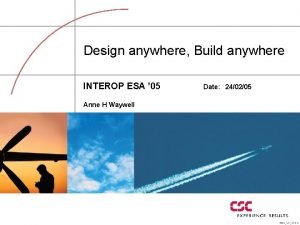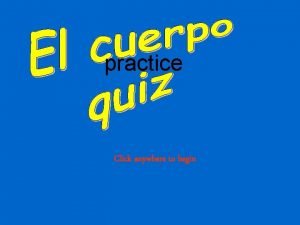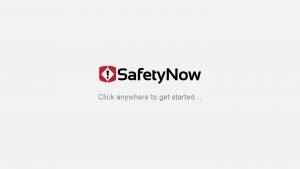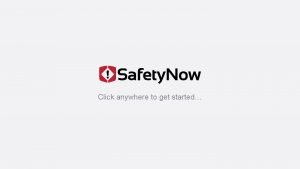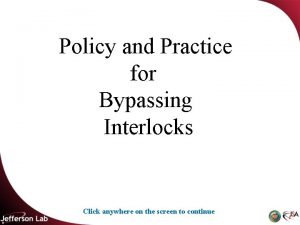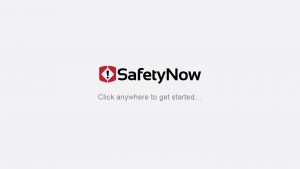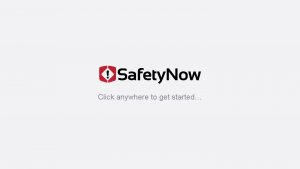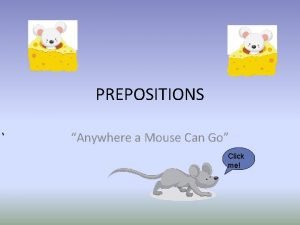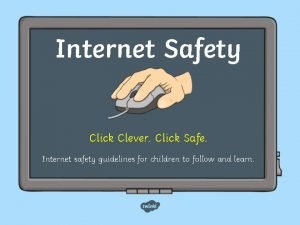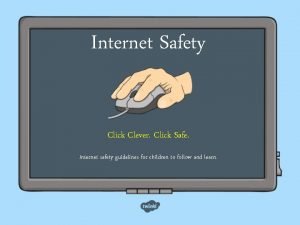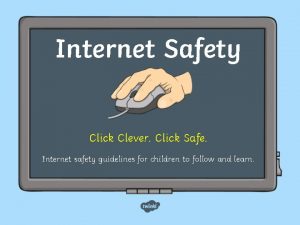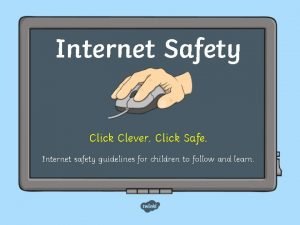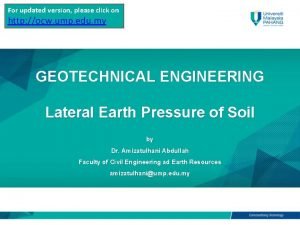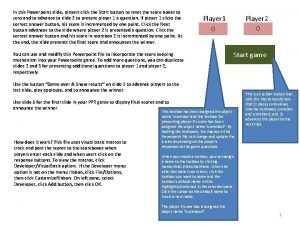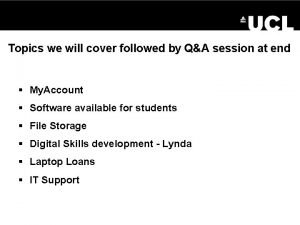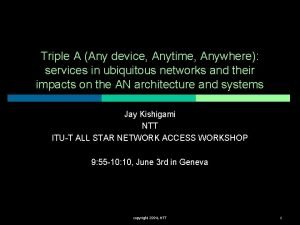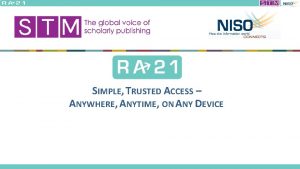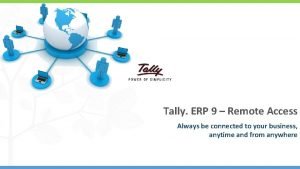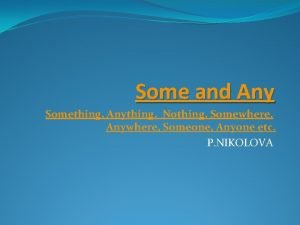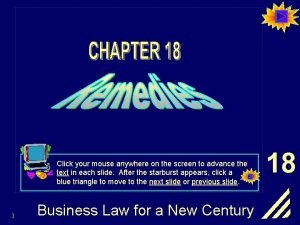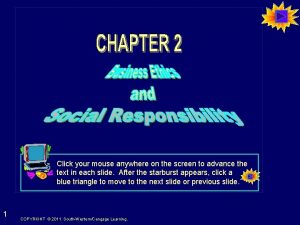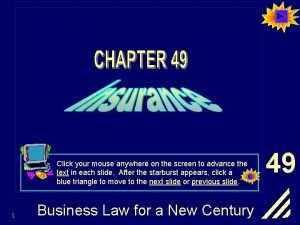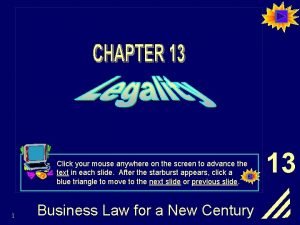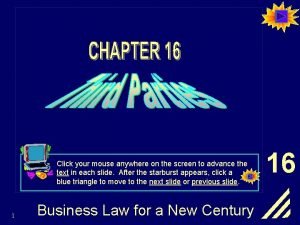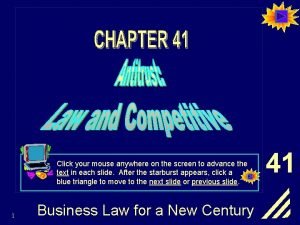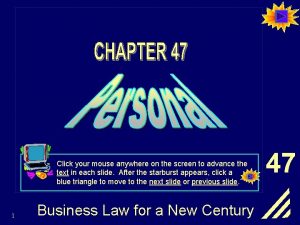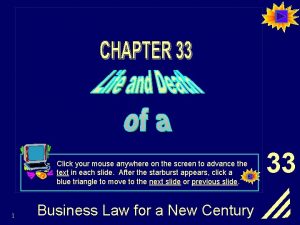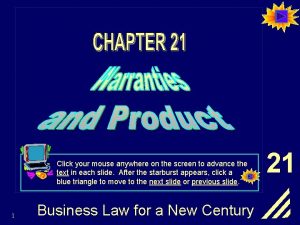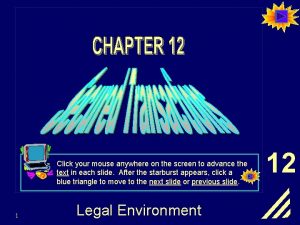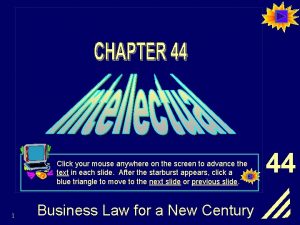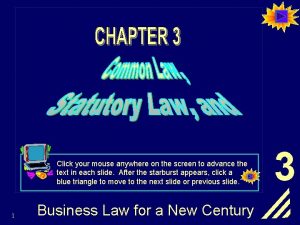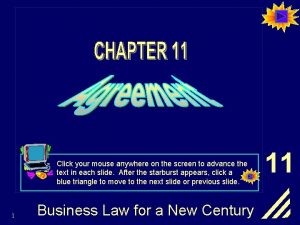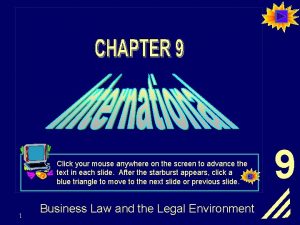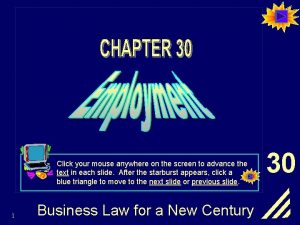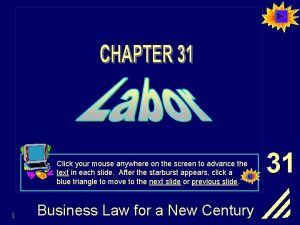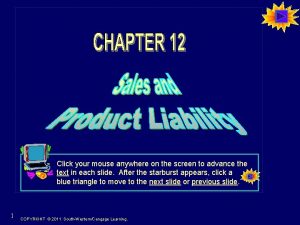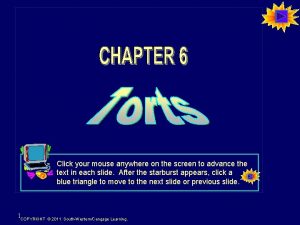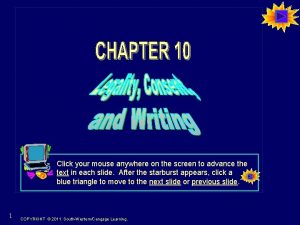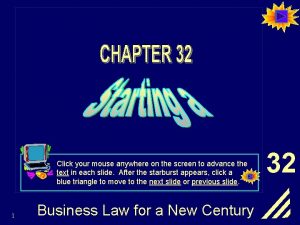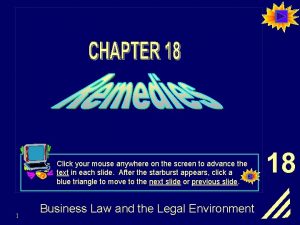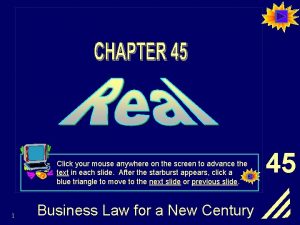Click your mouse anywhere on the screen to























- Slides: 23

Click your mouse anywhere on the screen to advance the text in each slide. After the starburst appears, click a blue triangle to move to the next slide or previous slide. 1 Legal Environment 4 p

Quote of the Day Progress everywhere today does seem to come so very heavily disguised as chaos. Joyce Grenfell, British actor 2 Legal Environment 4 p

Three Sources of Law 3 Legal Environment 4 p

Common Law p p p 4 Judge-made law; made up of all the decisions made by appellate courts. Two hundred years ago, almost all law was common law; most new law is statutory. Common law predominates in tort, contract, and agency law; it is important in property and employment law. Based on stare decisis, meaning “let the decision stand” (previous decisions are generally upheld in similar cases. ) Incorporates predictability and flexibility. Legal Environment 4 p

Changes in Common Law p Over time, changes in society’s norms have an effect on long-standing common law. An example of this is the law that applies to bystanders in emergencies. • Under common law, bystanders have no obligation to assist a victim in an emergency. • Over time, courts have created exceptions, making employers obliged to help an employee who is suddenly stricken with an emergency situation when the employer is present. • Some courts now hold that anyone witnessing an extreme situation or if there is a special relationship, such as patient-therapist, should be required to help, though this is not universal. 5 Legal Environment 4 p

Statutory Law p Most new law is statutory, that is, it is legislation passed by either a state legislature or the Congress of the United States. p Citizens who vote have some control over statutory law. We elect the state congressional representatives and the United States Senators and Representatives. 6 Legal Environment 4 p

How New Laws are Made p Any member of Congress can initiate a bill, p p p 7 or proposed law. A bill is debated in a committee in the house where it was introduced. It then goes to the full house for a vote. If it passes both houses this way, it goes to the President for his signature. A President’s signature turns a bill into law. If the President does not sign the bill (veto), Congress can override the veto by passing the bill again, with a two-thirds margin. Legal Environment 4 p

How New Laws Are Made If vetoed, it goes both houses If. Once the second Housepass of Congress made any changes, or amendments, to the bill, itback mustto the Congress, where If signed, bill becomes thetocompromise bill, Committee, it islaw. go a the Conference made up of members of both houses. Here, they workit must pass both houses sentcompromises to the President to out between the two different versions of the bill. The compromise bill thenby a 2/3 majority. be signed. goes back to both houses for a final vote. House of Representati ves Conference Committee After it passes committee, If it passes there, it goes thethe billother goeshouse to the (House full to body of that to Senate or house Senatefor toa vote. House). Banking, Finance, and Urban Affairs Education and Labor Senate It is assigned to a committee and the process repeats. Judiciary Committee Foreign Relations Appropriatio n A bill, or proposed law, is introduced in the House of Major Senate Major House Representatives or the Senate and then. Aeronautical assigned to a Committees Armed. Committees Ways and Armed Agriculture and Space committee for discussion and voting. Services Means Services Sciences 8 Legal Environment 4 p

Why Are Bills Proposed? p New issues or new worries – such as employment discrimination and Internet privacy or copyright issues p Unpopular judicial rulings – if Congress disagrees with a judicial interpretation of a statute, it may pass a new statute to “undo” the decision of the court, unless the decision at hand is based on the U. S. Constitution. p Criminal law – must be set forth in clear terms through statutes rather than left to judicial interpretation. 9 Legal Environment 4 p

Statutory Interpretation p Sometimes wording is ambiguous, either by oversight, or intentional -- as a compromise. p New laws must be interpreted by the courts. • Plain Meaning Rule -- the courts must use the common sense definition of words. • Legislative History and Intent -- sometimes the court can look to the reasons behind the law to determine the legislators’ intent. • Public Policy -- the courts will use accepted social policies, such as reducing crime or providing education to interpret a law. p Once the law (statute) has been applied by the courts, its interpretation becomes a precedent to be used in future court cases. 10 Legal Environment 4 p

Statutory Interpretation: Example p In 1963, President Kennedy proposed legislation to guarantee equal rights to African Americans in jobs, housing, voting, schools and other basic areas of life. p The bill was debated vigorously in Congress. • Wording was changed, terms added, meaning of phrases discussed and clarified. p Since the wording had changed through debate, a committee of members of both houses of Congress had to meet to reach a compromise. p Interpretation and enforcement of the Civil Rights Amendment varied with the make-up of the Supreme Court. 11 Legal Environment 4 p

The Other Player -- Money $ In today’s political climate, running a campaign for political office is an expensive endeavor. $ Financial contributions to candidates or political parties come from many sources. Some limits have been placed on contributions, but loopholes exist. $ Donors usually expect to receive some benefit, such as favored treatment in future legislative issues. $ Supporters of contribution limits aim to equalize the access to politics for rich and poor; opponents claim that the First Amendment guarantees their right to support whomever they choose. $ The very green bottom line is, MONEY TALKS -- and it often talks loudly in the political arena! 12 Legal Environment 4 p

Administrative Law 13 p Federal agencies such as the Federal Aviation Agency (FAA) and the Federal Trade Commission (FTC) and the Bureau of Land Management, all have the power to make regulations which affect citizens and businesses. p Agencies were -- and are -- created to fulfill a need. Someone needs to oversee changing technologies and practices and their effects on society. An agency is created when Congress passes enabling legislation, describing a problem and defining the agency’s powers. p Agencies often have considerable power in their areas of specialty, sometimes leading to controversy. The Administrative Procedure Act regulates how agencies operate, in an attempt to reduce the controversy. Legal Environment 4 p

Classification of Agencies p Executive Federal Agency: Part of executive branch, under the control of the President; usually support the President’s policies. p Independent Federal Not part of Federal Food and Bureau Drug Administration of. Agency: Investigation (FDA) (FBI) Nuclear Internal Regulatory Revenue Service Commission (IRS) executive branch; President does not have the power to fire the head of the agency. p Environmental Are agencies too powerful? ? Protection Agency (EPA) Securities Federal Trade and Exchange Commission (FTC) Federal Communications Commission (FCC) National Labor Relations Board 14 Legal Environment 4 p

Power of Agencies -Rulemaking p Two types of rules • Legislative rules -- require businesses and people to act a certain way; have the effect of a Congressional statute. • Interpretive rules -- these do not change the law; they define or apply the laws to new situations. 15 Legal Environment 4 p

Power of Agencies -Rulemaking p Three types of rulemaking • Informal rulemaking -- proposed rule must be published and public allowed to comment. • Formal rulemaking -- must hold a public hearing before establishing the rule. • Hybrid rulemaking -- some elements of both of the above -- perhaps the proposal and comment, with cross-examination, but not a full hearing. 16 Legal Environment 4 p

Power of Agencies -Investigation p Voluntary -- Some businesses freely give information and readily comply with agency recommendations. p Subpoena -- an order to appear at a hearing and produce evidence, sometimes documents. • Must be relevant to the investigation and under the agency’s jurisdiction, or area of authority. • Must not be unreasonably burdensome on the business. • Must not be privileged; this means that a corporate officer may not be required to incriminate himself. 17 Legal Environment 4 p

Power of Agencies -Investigation p Search and Seizure -- a legal search of a business, in order to take evidence of wrongdoing. • Most require a warrant before the search. • Some industries are closely regulated and may be searched at any time, with no warning. 18 Legal Environment 4 p

Power of Agencies -Adjudication p Adjudicate -- means to hold a hearing, then decide how to proceed with an issue. p Procedures for adjudication • • A hearing before an administrative law judge. Parties have counsel, but there is no jury. Informal; both sides present evidence. Judge makes ruling on testimony and evidence. p If parties are unhappy with results 4 p • Loser may appeal to an appellate board. • Appellate board may make a de novo decision, and ignore the administrative law judge’s decision. • Appeals go to a federal court. 19 Legal Environment

Limits on Agency Power p Statutory Control • The enabling legislation that created the agency places controls on it through requirements and restrictions. p Political Control • The President has control over agencies through political pressure and through nominations of agency heads. • Congress controls the budgets of agencies. They can eliminate funding for any program or an entire agency. • Congress can amend enabling legislation to place limits. 20 Legal Environment 4 p

Limits on Agency Power p Judicial Review • A party injured by an agency decision is entitled to an appeal in a federal court, after all appeal options are exhausted within the agency itself. p Informational Control and the Public • The Freedom of Information Act (FOIA) -- allows any citizen to request information from an agency. • The Privacy Act -- prohibits agencies from giving information about an individual to other agencies without consent. There are some exceptions. 21 Legal Environment 4 p

“Law is complex. The subject becomes less baffling if we understand how society creates law. ” 22 Legal Environment 4 p

Link to the Internet p Clicking on the orange button below will link you to the website for this book. (You must first have an active link to the internet on this computer. ) p Once there, click: • • p 23 Your text cover Interactive Study Center Select a Chapter Internet Applications You should then see web links related to that chapter. Legal Environment Click here! Click above to return to the slide show. 4 p
 Mercy bears richer fruits than strict justice
Mercy bears richer fruits than strict justice Metaphasepdm
Metaphasepdm Little mouse contract address
Little mouse contract address Click anywhere to continue
Click anywhere to continue Click anywhere to start
Click anywhere to start Click anywhere to start
Click anywhere to start Click anywhere to start
Click anywhere to start Click anywhere to start
Click anywhere to start Click anywhere to start
Click anywhere to start Anywhere a mouse can go
Anywhere a mouse can go Safety click
Safety click Click clever click safe campaign
Click clever click safe campaign Click clever click safe
Click clever click safe Click clever click safe
Click clever click safe Mouse click
Mouse click Screen small screen offscreen
Screen small screen offscreen Your score: 1 click here to start playing
Your score: 1 click here to start playing Give us your hungry your tired your poor
Give us your hungry your tired your poor Remote desktop ucl
Remote desktop ucl Any device anywhere
Any device anywhere Access anywhere anytime
Access anywhere anytime Goanywheremft
Goanywheremft Tally remote access
Tally remote access Something anything nothing etc
Something anything nothing etc

